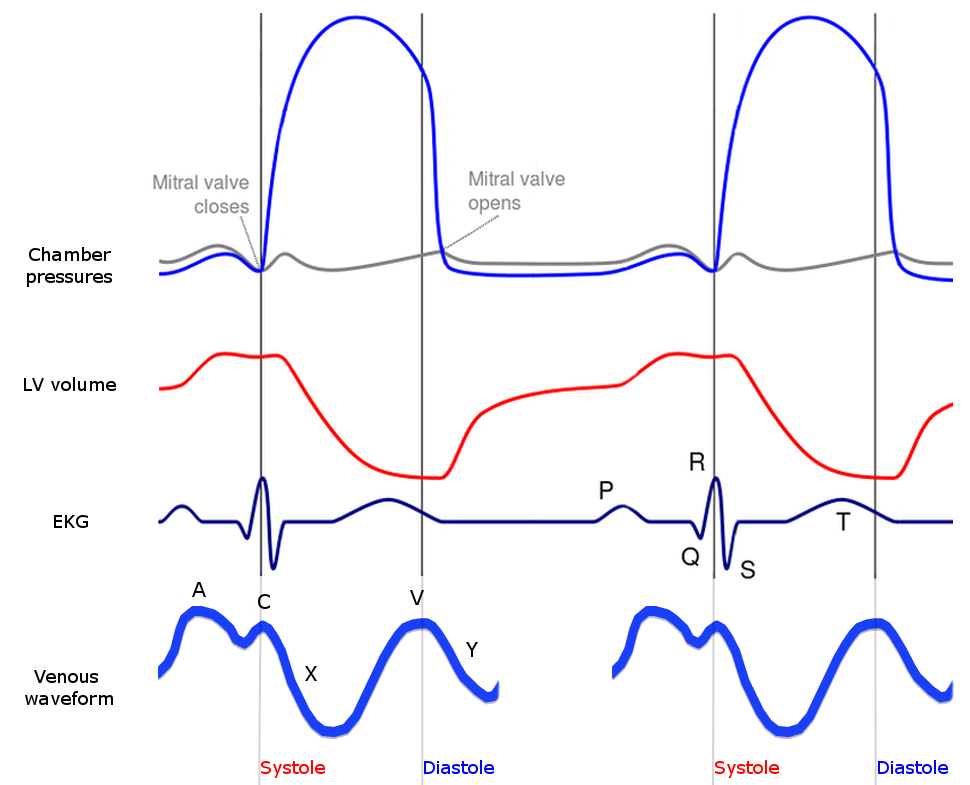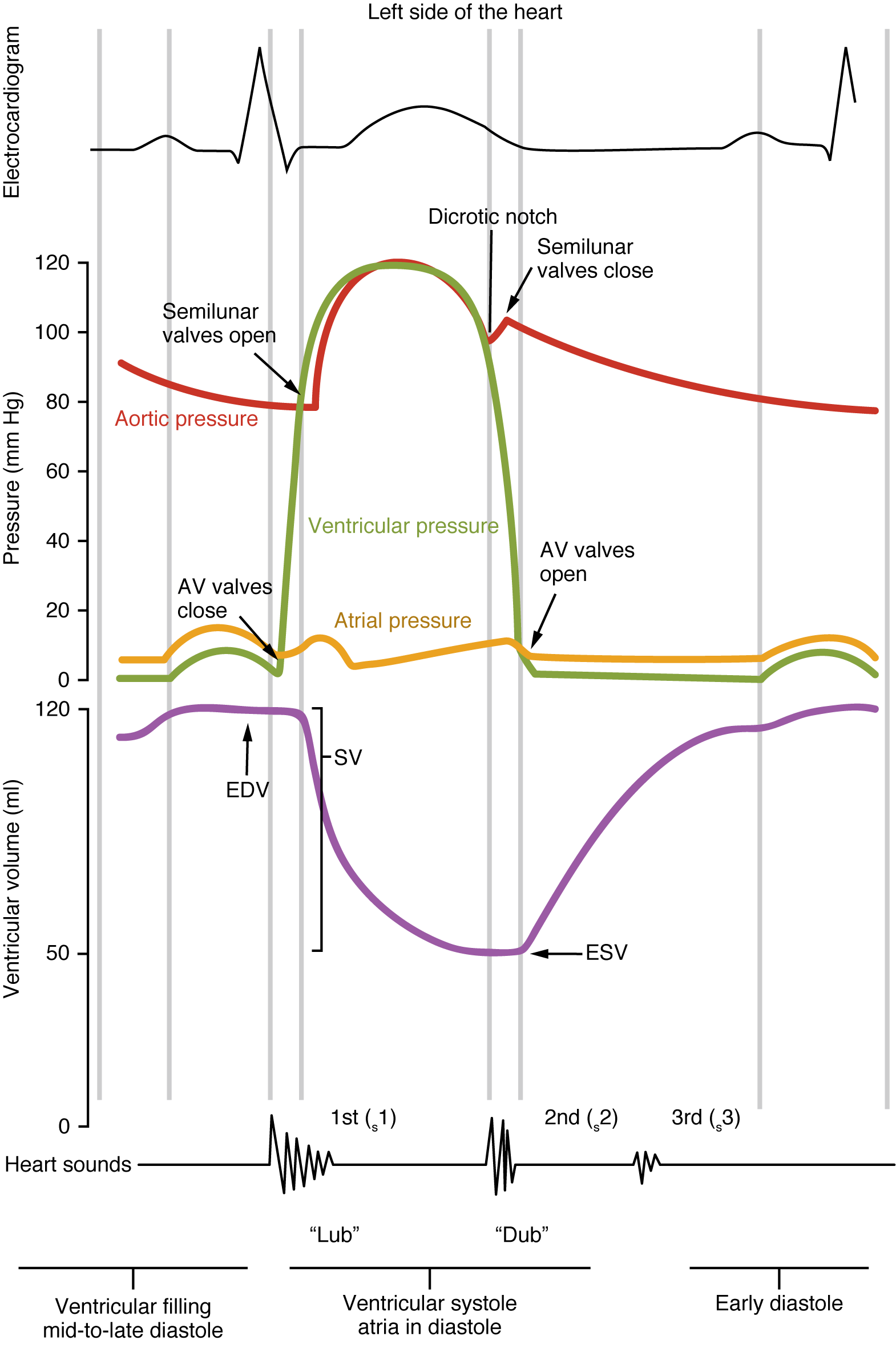The heart works in a cyclical fashion with systole and diastole alternating between each other, and the electrical, mechanical, and valvular events that make it happen also occur in an orderly, coordinated, cyclical fashion known as the cardiac cycle. In each cycle, the heart spends ⅔ time in diastole and ⅓ in systole. There are seven phases of the cardiac cycle as follows:

Atrial contraction against a stiff and less compliant ventricle gives rise to the fourth heart sound or S4. It can be seen in hypertension and in old age. “a” wave on JVP is lost in atrial fibrillation (AF). Big “a” waves called cannon “a” waves are seen in complete AV block.
Isovolumetric contraction: In this phase, the ventricles contract while the atrioventricular, pulmonary, and aortic valves are closed, i.e., as a closed chamber. The blood volume within the ventricle at this stage is equal to the end-diastolic volume or EDV. As no blood leaves the ventricle in this phase, it is called as isovolumetric contraction. It corresponds to QRS complex on ECG or ventricular depolarization. Isovolumetric contraction causes the intraventricular pressure to rise high. As the intraventricular pressure steadily rises and exceeds the atrial pressure, the AV valves close, giving rise to the first heart sound. Bulging of the mitral valve leaflets into the left atrium produce the positive “c” wave on the JVP which is followed right after by a negative “x” descent (named similarly as negative descent that follows “a” wave).
Rapid ejection: As the intraventricular pressure steadily rises and exceeds the aortic and pulmonary artery pressures, the aortic and pulmonary valves open, respectively. Valve opening leads to the ejection of blood into the major arteries. Peak ventricular pressures are reached in the beginning of the ejection phase.
Reduced ejection: This coincides with the appearance of the T wave on the ECG. Ventricular pressure starts to decline, and the amount of blood ejected also decreases. The AV valves are still open. The volume of blood that remains in the ventricle at the end of reduced ejection phase is equal to the end-systolic volume or ESV.
Isovolumetric relaxation: In this phase, the AV valves, aortic and pulmonary valves are closed again, and the ventricles start to relax, i.e., it marks the beginning of diastole. As the volume does not change, this phase is called isovolumetric relaxation. The volume that remains in the ventricle is the ESV. Closure of pulmonary and aortic valves is facilitated by a fall in ventricular pressures below the pulmonary artery and aortic pressures, respectively. A dicrotic notch or incisura can be seen on the aortic and pulmonary artery pressure tracings caused by temporary backflow of blood into the ventricles when the aortic and pulmonary valves close, respectively.
The second heart sound, or S2, can be heard when the pulmonary and aortic valves close. As the pulmonary valves close a bit later than the aortic valves, S2 is normally split. This split is increased during inspiration as the venous return increases to the right side of the heart during inspiration, causing P2 to be delayed. Concurrently, the left atrium is filled with oxygenated blood from the pulmonary veins, leading to a slow increase in the left atrial pressure, which is recorded as a positive “v” wave. Simultaneously, the right atrial filling can be recorded as a “v” wave on the right-sided pressure tracing.

Rapid filling: When the ventricular pressure falls below atrial pressure, the AV valves open, and blood from the atria will rapidly fill the ventricles. Consequently, the atrial pressure will fall, giving rise to the “y” descent on the JVP or atrial pressure tracing. When present, a third heart sound or S3 can be heard in this phase. S3 is an early diastolic sound also known as “gallop rhythm”. It can be heard physiologically in children, pregnant women, and young adults and pathologically due to ventricular dysfunction or volume overload in dilated or hypertrophic cardiomyopathies, acute valve regurgitation, heart failure, anemia, complete AV block, thyrotoxicosis, and left-to-right intracardiac shunts, etc.
Reduced filling or diastasis: The ventricles are still filling with blood from the atria, as a result of which the intraventricular pressure is steadily rising while the atrial pressure is falling. Diastasis is the longest phase of the cardiac cycle, and its duration shortens as the heart rate increases.

Sign up for free to take 13 quiz questions on this topic